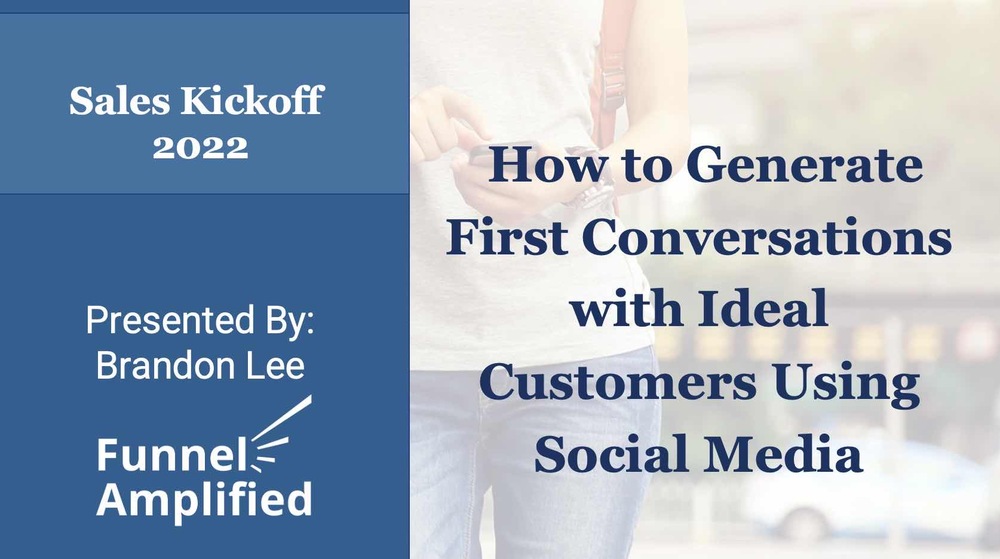My first sales job was as a paperboy when I was 10 years old. I didn’t know that I wasn’t only supposed to deliver papers to homeowners on my assigned route, but I was also expected to get more people on my route to purchase the paper.
I was good at folding papers, loading them into my bag, strapping the bad to the handlebars on my bike and riding my bike and tossing papers on my client’s porches. That was fun for me. But, in my 2nd month as a paperboy, I was told of a competition to see who could get the most “Starts.”
A Start was a new subscriber. I was told to go door-to-door and ask people if they would like to purchase the paper. It was awful. I knew how to walk door-to-door, I knew how to ring the doorbell and I knew how to say, “would you like to start getting the newspaper?” But, that was all I knew how to do. I was awful at it.
It could have been easy to conclude that knocking on doors asking people if they wanted to purchase the newspaper was the problem. But, honestly, the problem was me. I didn’t really know what to say, how to say it or to properly create conversations with my prospective customers.
Sales leaders and business leaders can be some of the most opinionated people in a company. Most of them have earned the right to have such strong opinions from experience and their successes. It is understandable they would also have strong opinions on social selling.
Here are some of the things Sales Leaders or business owners have shared about the problem with digital and social selling. Here are 11 problems with social selling most teams often face.
- Sales staff wastes time playing on social media. Too often, sales leaders had experiences with team members saying they were using social media for research or to send messages to prospects but didn’t have tangible results to show for their efforts.
With limited hours in a day, how can sales leaders ensure their team is using their time most productively?
- Sales professionals don’t know what to share in social posts. Social media platforms are for communication. If sales professionals don’t know what to share, then time spent on social media can be a waste of time.
Sales leaders do not want their team spending time researching information to share. It is considered a marketing task and not one for sales team members.
- Not knowing how to engage with prospects. Social media platform are for communicating with others. Sales professionals need to know how to comment on other’s social posts as a way to create more conversations that can be more productive towards a sales opportunity.
Sales professionals need to know how to share relevant information that captures other readers’ attention and gets them to comment back. They not only need to know how to write comments that lead to additional conversations, they need to know whose posts to comment on and how often they should do these activities. Creating a digital conversation that is more of a two-way conversation is beneficial for using social media. Without it, social media will not live up to its potential.
- Sharing information that is off-brand or sharing information that does not follow brand guidelines. Some organizations are very concerned about brand guidelines. They expect all social posts, even those published to individuals personal social media profiles follow the same brand guidelines. This includes using the right logos, colors and even describing products and services.
- Using social posts to promote your products / services. One very big problem with social media is when it is only used to promote a company’s products and services alone. It is called social media because it is meant to be two-way communication. When the only social posts are promotional, they tend to be ignored and therefore do not contribute to sales success.
When the only social posts that are published are promotional, the data shows they are less likely to be viewed or engaged with. One of the biggest problems with social media for sales professionals is the type of posts sales professionals share in any social media platform including LinkedIn.
- Inconsistency. Random acts of sharing content is not going to make an impact. Randomly sharing social posts does not contribute to a consistent message. Randomly publishing content will not work other than the occasional lucky timing that captures a buyer at just the right time.
The algorithms do not give favor to random posts. Algorithms are designed to show content to users that they are most likely to find value. Randomly sharing posts does not create consistency with engagement so the algorithms don’t have sufficient information to make good decisions of whom to display these posts. So, randomly published posts by individuals tend to get limited views in the newsfeeds.
- Lack of training. Like any other activity, if sales professionals are not properly trained, they will most likely not maximize return on their time investment. Social selling, or as I also like to call it, social prospecting takes practice and has nuances that are specific to social activity.
For example, the same activities used for cold emails will not work for face-to-face conversation. The same tactics used to get visitors to a booth at a trade show are not the best tactics to get visitors to a landing page.
Social selling activities are most beneficial to winning new deals are specific to social platforms. Too often, sales professionals, and therefore their sales leaders, will conclude social is not a valuable use of sales professionals’ time because of a lack of results. From my experience, it is not that social selling does not work but the wrong selling activities were applied to social media platforms.
Imagine reading a brochure to a prospect when they answer your phone call. I doubt any sales professional would do this. However, the equivalent action is done daily on every social media platform.
- Lack of goals / purpose. What do you want to accomplish with social media? If the answer is closed deals, then social media will not be valuable to B2B sales teams.
Consider social media like other tools used to start conversations with ideal customers. As an example, why do companies choose to invest money in a particular trade show versus other trade shows? It is usually about the audience who will be there and the opportunities to meet them. These tend to be activities to meet new costumes and begin the relationship in order to provide a service or sell a product.
Too often sales professionals conclude social selling doesn’t work because of their lack of consideration for goals and outcomes expected.
- Bad messaging. Similar to #5 above, bad messages for the channel will not create desired results. Consider again the trade show booth. When a visitor first walks into a booth, does sales start in a sales pitch? Hopefully they don’t.
The best strategic activity is to ask questions from the visitor to determine their needs or goals to consider how best to serve them. It is a process to help create the right conversation or buyer journey for your visitor.
Social media must be used in a similar fashion. It is a great channel to listen to customers and then provide information and insights that can help buyers feel empowered to make a good decision for their business.
- Not having the right tools. Providing a sales professional with Sales Navigator and a hearty pat on the back with an encouraging, “go get ‘em” is not enough. It is reminiscent of the days of giving a sales professional a desk, phone and the Yellow Pages and telling them to start selling. There are tools to help individuals quickly find the right content to share, craft a message that is suitable for their ideal customer and publish it quickly. There are also tools to help create social posts that are visually appealing and follow brand guidelines.
11. Lack of KPI’s. Sales organizations are driven by KPI’s. It considered one of the ways leadership can evaluate sales professionals and ensure they are performing their required activities. As part of the team’s MBO’s plans, sales professionals are expected to perform minimum daily or weekly activities like cold calls and enrolling individuals into email cadences.
A challenge for many sales leaders has been the lack of social-based data to create a KPI plan and hold sales professionals accountable to them. This is a challenge that most be overcome for any enterprise level sales organization and many sales teams of various sizes. Lack of KPI’s, lack of strategical goals and lack of the right tools all provide a big obstacle for promoting a social selling aspect to a sales playbook.
The data on the value of social as a channel for sales professionals is very compelling. One study on the global SAP Social Selling Report found social selling professionals were 90% more likely to exceed quota and had a 300% larger average deal size than their non-social selling colleagues. This study was done in 2018 which means it was before the global pandemic.
Since the data is so compelling, leaders need to find ways to incorporate digital and social methods into their existing sales playbooks while overcoming the challenges that come with it. Are there any other challenges you would add to this list?



